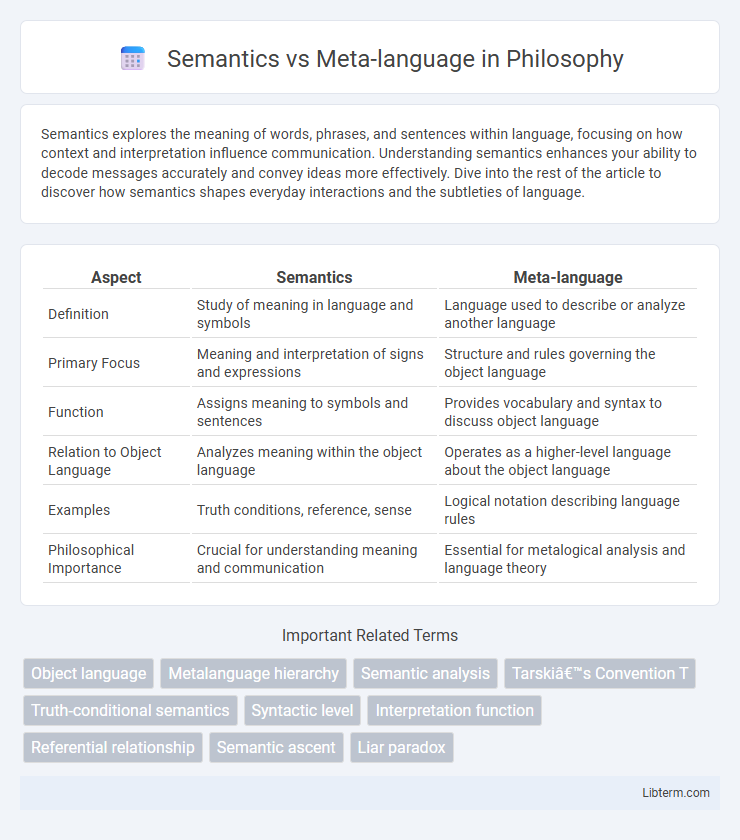Semantics explores the meaning of words, phrases, and sentences within language, focusing on how context and interpretation influence communication. Understanding semantics enhances your ability to decode messages accurately and convey ideas more effectively. Dive into the rest of the article to discover how semantics shapes everyday interactions and the subtleties of language.
Table of Comparison
| Aspect | Semantics | Meta-language |
|---|---|---|
| Definition | Study of meaning in language and symbols | Language used to describe or analyze another language |
| Primary Focus | Meaning and interpretation of signs and expressions | Structure and rules governing the object language |
| Function | Assigns meaning to symbols and sentences | Provides vocabulary and syntax to discuss object language |
| Relation to Object Language | Analyzes meaning within the object language | Operates as a higher-level language about the object language |
| Examples | Truth conditions, reference, sense | Logical notation describing language rules |
| Philosophical Importance | Crucial for understanding meaning and communication | Essential for metalogical analysis and language theory |
Introduction to Semantics and Meta-language
Semantics studies the meaning of words, phrases, and sentences within a language, analyzing how linguistic elements convey information and intention. Meta-language is the language used to describe, analyze, or interpret another language, enabling discussion about linguistic structure and meaning. Understanding the distinction between semantics and meta-language is essential for linguistic theory, as semantics addresses content while meta-language provides the tools for linguistic analysis.
Defining Semantics: Meaning in Language
Semantics explores the meaning of words, phrases, and sentences within a language, analyzing how language conveys information and intention. It studies the relationship between linguistic expressions and their referents in the real or conceptual world, emphasizing meaning as a core component of communication. Meta-language, by contrast, serves as a tool to describe, analyze, or interpret the semantics of the object language without embedding meaning itself.
Understanding Meta-language: Language About Language
Meta-language refers to a specialized language used to describe, analyze, or discuss other languages, enabling clear communication about linguistic structures and functions. It provides tools such as grammar terms, syntactic rules, and semantic categories that help in systematically understanding and interpreting language. Semantics, by contrast, focuses on the meaning within a language itself, while meta-language operates at a higher level, framing and explaining these meanings in an explicit, structured way.
Historical Perspectives on Semantics and Meta-language
Historical perspectives on semantics trace back to ancient philosophers like Aristotle, who laid the groundwork for understanding meaning and reference in language. Meta-language, evolving primarily in the 20th century through figures such as Alfred Tarski, emerged as a formal language used to describe, analyze, and evaluate object languages and their semantic properties. The development of meta-language theory marked a significant advancement in linguistic philosophy, enabling precise discussions about truth, meaning, and the structure of language systems beyond traditional semantic analysis.
Key Differences Between Semantics and Meta-language
Semantics studies the meaning of linguistic expressions and how these meanings are interpreted within a language system. Meta-language is a language or set of terms used to describe, analyze, or discuss another language, often referred to as the object language. Key differences include semantics dealing with meaning and interpretation, whereas meta-language focuses on language about language, providing tools for explaining or evaluating the semantics of the object language.
Applications of Semantics in Linguistics
Semantics in linguistics focuses on the meaning of words, phrases, and sentences, enabling precise interpretation and communication analysis. It plays a crucial role in natural language processing, language acquisition studies, and lexical semantics for understanding how meaning is constructed and transferred. Meta-language, by contrast, refers to language used to describe or analyze another language, essential for developing frameworks and theories but secondary to direct semantic applications.
The Role of Meta-language in Communication
Meta-language plays a crucial role in communication by providing a framework to describe, analyze, and discuss the features of language itself. It allows speakers to clarify meanings, resolve ambiguities, and facilitate understanding by referencing linguistic elements beyond the immediate message. In semantics, meta-language enables the precise articulation of meaning, contributing to effective interpretation and enhanced dialogue.
Semantic Analysis vs. Meta-linguistic Analysis
Semantic analysis systematically examines meaning in language by interpreting word relationships, sentence structure, and context to uncover underlying concepts and intents. Meta-linguistic analysis explores language about language, focusing on how speakers reflect on, describe, and manipulate linguistic features from an external perspective. While semantic analysis deciphers inherent meaning within discourse, meta-linguistic analysis evaluates the properties, functions, and usage of language as an object of study.
Challenges in Distinguishing Semantics from Meta-language
Distinguishing semantics from meta-language poses challenges due to the overlapping use of linguistic structures and terminology in describing language meaning. Semantics studies the meaning of expressions within a language, while meta-language involves language used to talk about that language, often blurring boundaries during analysis. This overlap complicates clarity, especially in fields like linguistics and computer science where precise interpretation of meaning and representation is essential.
Future Trends in Semantics and Meta-language Studies
Future trends in semantics and meta-language studies emphasize the integration of artificial intelligence and natural language processing to enhance meaning representation and contextual understanding. Advances in computational linguistics focus on dynamic meta-language frameworks that adapt to evolving semantic contexts across diverse languages and cultures. Research increasingly explores the interplay between semantic web technologies and meta-language tools to facilitate more intuitive human-computer interaction and knowledge management.
Semantics Infographic

 libterm.com
libterm.com